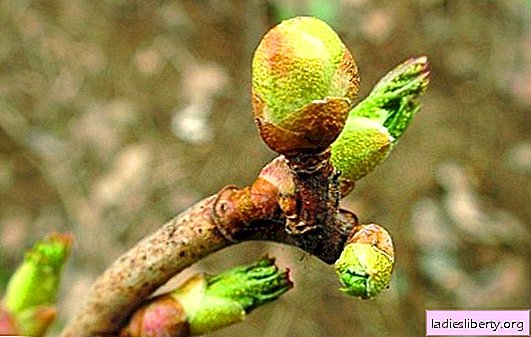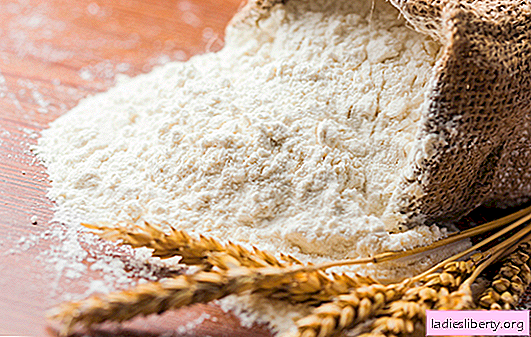
Currants are one of the most common berry crops among gardeners.
It contains a large amount of vitamins in its berries and leaves. In addition, the agricultural technology of currants is quite simple.
However, in spite of its unpretentiousness, plantings of this culture can be severely affected by the invasion of pests such as currant buds and spider mites.
Despite their microscopic size, these insects cause significant damage to currants due to their numbers (they give several generations per season).
If the fight against these pests is not started in time, then the crop will be lost, and the plants will die.
Ticks spread by contact (birds, on human clothing and tools when processing bushes) and wind.
Currant kidney mite
This type of tick affects the currant buds. Its dimensions are so small that without a magnifying glass it is almost impossible to detect (females reach a length of 0.2-0.3 mm, males are smaller). However, its appearance on the currant can be judged by the traces of its activities. Kidney ticks live in the kidneys. They carry viral diseases (for example, leaf curl virus), which greatly weaken currants. In addition, bushes affected by these parasites are exposed to active infection by barbel, goldfish, and stem glassware. In spring, when + 10-12 ° C of heat is established, females lay up to 18 thousand eggs. If the damaged kidney is broken, it will be filled with a continuous mass of vitreous eggs. Larvae hatch after 6-10 days.
Kidney tick, affected kidney in section

Signs of currant damage by a kidney tick:
• in autumn and winter, infected kidneys are enlarged, have a round shape;
• in spring ticks begin to feed and multiply intensively. Affected buds either do not shoot at all, leaves and for the most part die. By the period of "green haze" on the bushes (the beginning of leaf dissolution), 2 generations of ticks are already developing in the buds (up to 1000 individuals can live in one bud). As a result of intensive reproduction, it becomes crowded, and insects get out in search of young shoots and buds in the axils of the leaves. So pests spread through the bush and crawl to neighboring plants. Full-grown shoots and leaves from damaged buds do not grow. Little flower brushes are formed; flowering is weak.
• summer infected bushes have a disheveled shape, shoots are partially curved and underdeveloped. The leaves are deformed, their tops brighten and acquire a leathery appearance. Berries crumble before reaching full maturity. Since August, the kidneys, in which new generations of ticks settle, begin to grow and become rounded.

Kidney-damaged mites (shown by red arrows in the photo) are rounded and almost 2 times larger than healthy kidneys
Methods for controlling kidney currant tick
There are several ways to deal with this pest. Their use depends on the stage at which the tick was discovered. Many gardeners use pouring boiling water over currant bushes. At the same time, the tick larvae die, and the plant increases immunity to powdery mildew.
This procedure should be carried out according to the following rules:
• 100% of boiling water is not used - while the water is carried into the garden, poured into a watering can, it manages to cool slightly and does not damage the kidneys themselves, but the pests die (they are sensitive to high temperatures);
• bush branches are previously tied together;
• when the kidneys began to open, they can no longer be doused. If the deadline is missed, then the procedure can be carried out in the fall, when the leaves fall and affected rounded buds are visible.
Mechanical removal of the kidneys
This method will require patience and care from the gardener. Sorting of the kidneys is carried out in winter or spring, until they open. The disadvantage of this method is that it is time-consuming, with the wrong difference (before opening all the kidneys have a swollen appearance), it is more likely to remove healthy kidneys instead of infected ones. In addition, the gardener will need to carefully examine all branches of the bush: if you miss at least one infected bud, then the spread of ticks will continue. After collecting the kidneys they are burned.
Cardinal cropping
If at young bushes, at least 30-40% of the branches are damaged by a kidney mite, then in the spring they need to be cut for a stump and burn. Treat wounds with Nitrafen. Do not throw trimmed branches to the ground, as pests can get into healthy plants. In July, overgrown new shoots thin out, leaving the most powerful. In a year they will begin to bear fruit. Heavily damaged 6-year-old bushes and older cannot be saved, they are uprooted and burned in the same place.
Sulfur Treatment
The kidney mite does not tolerate sulfur, therefore, to combat it, use a solution of colloidal sulfur (10g / bucket of water), karbofos (75g / 10l of water) or calcareous broth (ISO). These drugs are sprayed with currant bushes during flowering and after its completion. When reprocessing, the concentration of the substance is reduced by 2 times. In some varieties of currant, sulfur-containing preparations can cause burns and premature leaf fall.
Use of Acaricides
Ticks are not insects, but arachnids, so the use of insecticides will not have the desired effect on them. For this, acaricides and insectoacaricides are used, for example, Apollo, Vertimek, Oberon, Nissoran, Envidor, Sunmayt. In addition to ticks, these drugs will also destroy other pests.
Folk ways
Cuttings of currants before rooting can be soaked in tea broth. To prepare it, 50 g of tea is brewed in 25 l of boiling water. You can use it in a day, otherwise a burn of twigs is possible. In the resulting solution, the cuttings can withstand 3 hours.
To fight against ticks, currant bushes are treated with a garlic solution during budding and immediately after flowering. For its preparation, 200 g of chopped garlic cloves are poured with 10 liters of water, mixed, filtered and used immediately.
Growing kidney mite resistant varieties of currant
Some varieties of currants are relatively resistant to damage by this pest. These include: Otradnaya, Early Potapenko, Vigorous, Early sweet, Memory of Gubenko, etc.
You need to purchase planting material from trusted suppliers. If there is no complete confidence in the "purity" of seedlings or cuttings, then they can be disinfected in this solution: take agrovertin (10 g) and colloidal sulfur (40 g) per 10 l of water. If you need to save your favorite variety on your site, then cuttings from this bush are cut before the snow begins to melt - during this period, female ticks have not yet begun to lay their eggs. Cuttings are etched for 15 minutes in a 1-5 solution of malathion or agrovertin.
Spider mite on currant
This type of tick is the most common pest that parasitizes on almost many plants. Spider mites are arachnids, have 4 pairs of legs, small size (0.3-0.6 mm). Larvae and adults feed on the cellular sap of leaves and young shoots. As a result of their activity, some of the cells die, photosynthesis decreases, the plant weakens and is less able to withstand infections.
Spider mite

Spider mites live on the underside of leaves in colonies, numbering several hundred individuals. Their color is different (red, brown, yellowish-green, orange) and depends on various factors. Wintering takes place under leaf litter or in the upper layers of the soil. In spring, when the kidneys dissolve, ticks move to plants. The first generation of insects can parasitize on weeds, and from them already migrate to cultivated plants. Affected bushes tolerate winter worse and lose productivity. The life cycle of the tick is 12-23 days depending on humidity and temperature conditions (optimal for their rapid development + 27-30 ° C with low (less than 60%) air humidity). Females during the period of their life lay several hundreds of eggs that mature in 3 days. Spider mites are also carriers of various infections, both viral and fungal etiology.
Signs of currant damage with a spider mite
One of the very first signs of the appearance of a spider mite is the appearance of yellow dots (the place of bites) on the leaves. Gradually, the leaf acquires a marble color, and then turns yellow. As a result, the sap flow in the leaf blade is disrupted, the leaves become dehydrated and dry.
In advanced cases of damaging currants with a spider mite - the presence of a thin web on the plant in which insects arrange their nests.
Web on a highly affected spider mite plant

Spider mite on currant: how to fight?
They begin to fight spider mites before females lay their eggs in spring.
Chemical treatment with acaricides
For this, currant bushes are sprayed with solutions of acaricides until buds open. For example, biologically active drugs such as Fitoverm, Kleschevit, Agrovertin, Akarin, Iskra, Bitoksibacillin provide protection against ticks and other pests for 20 days. The death of ticks occurs on the 2nd day. These drugs are not dangerous for birds, fish, predator insects, but dangerous for bees. Therefore, it is better to use them before the flowering of plants begins. Spraying is carried out with a fresh solution in dry, calm weather, evenly moistening the leaves on both sides. Processing is carried out several times with an interval of 4-5 days. It is worth remembering that ticks quickly develop resistance to poisons, so when processing plants, it is necessary to alternate chemicals. So, Sunmight acts on all stages of ticks (from eggs to an adult), but quickly becomes addictive and the emergence of populations resistant to it. Use it once a year. Apollo, Fufanon, Nissoran have a sterilizing effect.
Agricultural Compliance
Spider mites cannot tolerate high humidity. Using this weak spot of the pest, you can halve its population. It is especially important to irrigate or spray currant bushes in hot, dry weather, while trying to get water to the underside of the leaves.
In autumn, on the site, it is necessary to collect fallen leaves and burn them, because they are the wintering place for spider mites.
Throughout the growing season, it is important to destroy weeds on the site, which are a nursery of pests.
Folk methods
Many gardeners and summer residents do not accept chemicals and prefer to fight spider mites with folk methods.
With a small number of ticks, currant bushes are sprayed with garlic infusion. For this, 150 g of dry leaves and husks are poured into 10 liters of warm water and insisted for a day. After that, the obtained infusion conducts the processing of the plant. Instead of dry leaves, you can use 200 g of garlic or onions instead of dry leaves. The infusion time is 2 hours.
Mustard infusion gives a good effect: take 200 g of powder in a bucket of water, insist 10-12 hours, filter and spray the currant.
If a dandelion grows on a site, then it is also used to combat spider mites. 200 g of crushed roots and 50 g of leaves are poured with 10 liters of warm (40 ° C) water, insisted for 2-3 hours and filtered. Currants are sprayed for the first time during the period of “green haze” (leaf dissolution), the second after flowering.
In early spring, you can collect the roots and leaves of black bleached and make a decoction of them: 2 kg of fresh raw materials are poured with a small amount of water and boiled for 2-3 hours. After the broth is added 10 liters of water. The plant is poisonous, so all manipulations with it are carried out with gloves.
Horseradish infusion is quite effective: leaves (1 kg) are crushed in a meat grinder, insist 60 minutes in 3 liters of water. If you use the roots, then they will need 2 times less.
Subject to agricultural technology, currants will be less often exposed to various diseases and be affected by ticks.











